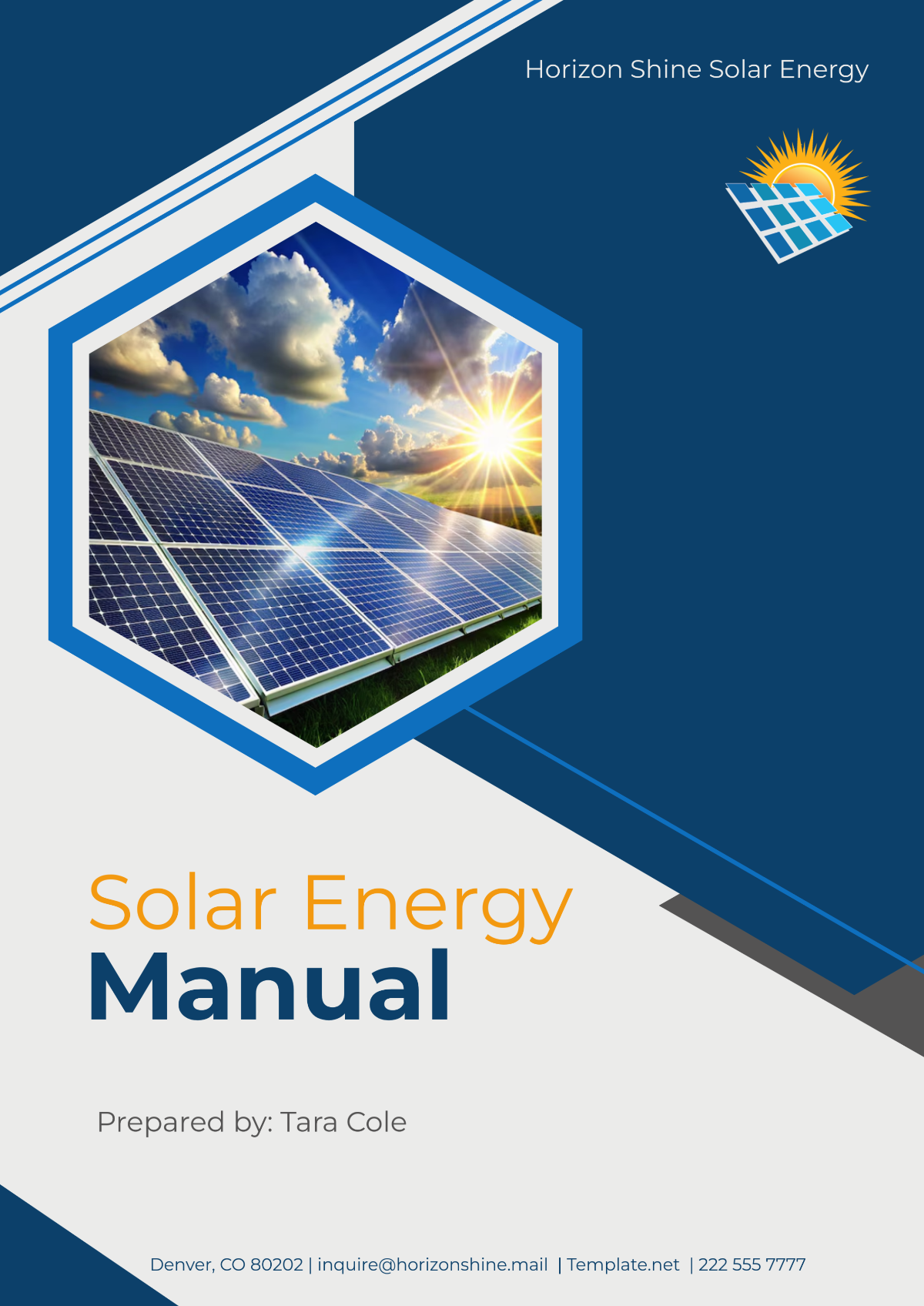Free Solar Energy Manual

I. Introduction
A. Overview of Solar Energy
Solar energy is harnessed from the sun’s rays through various technologies and systems designed to capture, convert, and utilize this abundant resource. This energy can be transformed into electricity or heat, serving numerous applications in residential, commercial, and industrial sectors. Solar energy is classified as a renewable resource, which signifies that it is naturally replenished and can be utilized without depleting the Earth's resources. The implications of solar energy's widespread adoption are profound, especially as we transition to a future where sustainability is paramount, and energy demands continue to escalate.
B. Importance of Solar Energy
The importance of solar energy cannot be overstated in the context of contemporary environmental challenges. As nations confront climate change and the adverse effects of global warming, the shift towards renewable energy sources, such as solar, is essential. Fossil fuels, while historically dominant, contribute significantly to greenhouse gas emissions and air pollution, both of which are detrimental to health and the environment. In contrast, solar energy offers a clean and sustainable alternative that not only mitigates environmental degradation but also enhances energy security and reduces dependence on volatile fossil fuel markets. By diversifying energy portfolios with solar power, nations can foster economic stability and resilience.
C. Objectives of This Manual
The primary objective of this manual is to provide a comprehensive understanding of solar energy systems, including their components, installation processes, benefits, and maintenance requirements. The manual aims to educate homeowners, businesses, and professionals in the field about the practical and technical aspects of solar energy. Furthermore, it seeks to empower readers to make informed decisions regarding the adoption of solar technologies, promoting both individual and collective action toward sustainable energy practices. By the end of this manual, readers should have a thorough understanding of solar energy's potential and the tools to harness it effectively.
II. Solar Energy Basics
A. What is Solar Energy?
Solar energy refers to the radiant light and heat emitted by the sun, which can be captured and converted into usable forms of energy. The sun emits approximately [1,366] watts of energy per square meter at the outer surface of the Earth’s atmosphere, which is an immense amount of energy—enough to power the entire planet multiple times over. However, due to atmospheric absorption, scattering, and reflection, only about [1,000] watts per square meter reach the Earth’s surface on a clear day. This energy can be harnessed through various technologies, allowing us to convert sunlight into electricity for homes and businesses, or into thermal energy for heating purposes.
B. Types of Solar Energy Systems
1. Photovoltaic (PV) Systems
Photovoltaic systems are designed to convert sunlight directly into electricity through the use of semiconductor materials, typically silicon-based solar cells. When sunlight strikes the solar cells, it energizes electrons, creating an electric current. These systems can be scaled to meet varying energy needs, from small residential units capable of powering a single home to large-scale solar farms generating megawatts of electricity for the grid. The flexibility and scalability of PV systems make them a popular choice for both residential and commercial applications.
Furthermore, PV systems can be configured in several ways, such as grid-tied systems, which connect to the electrical grid, or off-grid systems, which are designed for remote locations where grid access is unavailable. The latter often includes battery storage solutions to ensure a continuous power supply, even during periods of low sunlight.
2. Solar Thermal Systems
Solar thermal systems, unlike photovoltaic systems, utilize solar energy primarily for heating rather than electricity generation. These systems consist of solar collectors that absorb sunlight and convert it into heat, which is then transferred to a fluid, typically water or a heat-transfer liquid. This heated fluid can be used directly for heating applications, such as space heating in buildings, or for producing hot water for domestic use.
Solar thermal systems can also be employed in larger applications, such as district heating systems or industrial processes that require substantial amounts of heat. The efficiency of solar thermal systems is particularly high in sunny regions, making them an attractive option for water heating in homes and businesses.
C. How Solar Energy Works
The conversion of solar energy into usable forms involves several distinct steps:
Solar Radiation Capture: Solar panels or collectors capture sunlight as it strikes their surfaces. The efficiency of this process depends on various factors, including the angle of sunlight, shading, and the cleanliness of the panels.
Energy Conversion: In photovoltaic systems, the captured sunlight is converted into electricity via the photovoltaic effect, while in solar thermal systems, sunlight is converted into heat through the absorption of solar radiation by the collectors.
Energy Storage and Distribution: The generated electricity can be used immediately to power electrical appliances, stored in battery systems for later use, or fed back into the electrical grid. In the case of solar thermal systems, the heated fluid can be stored in insulated tanks for later use in space heating or domestic hot water applications.
Grid Interaction: Many solar energy systems are connected to the electrical grid, allowing excess energy to be fed back into the grid. This interaction can create credits for the energy produced, helping to offset the cost of electricity consumed from the grid.
III. Benefits of Solar Energy
A. Environmental Benefits
Solar energy is one of the cleanest and most environmentally friendly energy sources available today. By utilizing solar power, individuals and organizations can significantly reduce their carbon footprints and lessen their contributions to climate change. According to studies, transitioning to solar energy can reduce carbon emissions by up to [1,000] tons per year for an average-sized solar farm. This reduction is pivotal in combating the harmful effects of greenhouse gases, which contribute to global warming and climate instability.
Moreover, solar energy generation does not produce air pollutants, contributing to improved air quality. As the world grapples with health issues linked to pollution from fossil fuel combustion, the adoption of solar energy can lead to healthier communities and ecosystems. Furthermore, utilizing solar energy reduces reliance on finite resources, preserving natural habitats and ecosystems that are often disrupted by traditional energy extraction methods.
B. Economic Benefits
The economic benefits of solar energy are substantial and multifaceted. Over the past decade, the cost of solar panels has decreased dramatically, making solar energy more affordable for consumers and businesses alike. According to recent data, the cost of solar energy has fallen by over [80%] since [2010], enabling a broader segment of the population to invest in solar technology.
In addition to reducing electricity bills—often resulting in savings of [20%] to [50%] on energy costs—solar energy systems can increase property values. Homes equipped with solar installations may see their property value rise by [4%] to [6%], providing a strong financial incentive for homeowners. Additionally, the solar industry has become a significant job creator, employing thousands of workers in manufacturing, installation, and maintenance sectors. As the demand for solar technology increases, job opportunities in these fields are projected to continue growing, contributing to local and national economies.
C. Energy Independence
Solar energy provides a pathway to energy independence, allowing individuals and communities to generate their own power and reduce reliance on imported fossil fuels. By harnessing solar power, users can take control of their energy production, potentially leading to lower energy costs and increased energy security. This transition is especially crucial in regions prone to energy supply disruptions or fluctuating fossil fuel prices.
As solar energy systems can be deployed at various scales—from small residential installations to large utility-scale solar farms—they offer flexibility in meeting energy needs. Local governments and communities can benefit from investing in solar infrastructure, promoting energy resilience and stability. Furthermore, as solar technology continues to advance and costs decline, the feasibility of achieving energy independence becomes increasingly attainable for a broader segment of the population.
IV. Solar Energy System Components
A. Solar Panels
Solar panels are the most visible and critical component of a solar energy system. They are typically composed of photovoltaic cells that convert sunlight into electricity. The efficiency of solar panels is a key factor in determining how much energy can be generated from a given amount of sunlight. Modern solar panels have efficiencies ranging from [15%] to [22%], with ongoing advancements in technology continually improving these figures.
Solar panels are typically installed on rooftops or mounted on the ground, depending on the site’s configuration and available space. When selecting solar panels, it's essential to consider factors such as efficiency, warranty, and the manufacturer's reputation. High-quality panels often come with warranties of [25] years or more, providing assurance of their long-term performance.
B. Inverters
Inverters play a vital role in solar energy systems by converting the direct current (DC) electricity generated by solar panels into alternating current (AC) electricity, which is the standard form of electricity used in homes and businesses. Inverters also manage the flow of electricity to ensure that it matches the grid's voltage and frequency, optimizing energy production.
There are various types of inverters, including string inverters, microinverters, and power optimizers. String inverters are commonly used for residential systems and connect multiple solar panels in series. Microinverters, on the other hand, are attached to each panel individually, allowing for greater flexibility and efficiency, particularly in installations where shading may be an issue. Power optimizers work in conjunction with string inverters to enhance performance by optimizing the output of individual solar panels.
C. Battery Storage Systems
Battery storage systems are becoming increasingly important in solar energy installations, particularly as the demand for energy independence grows. These systems store excess electricity generated during the day for use during the night or periods of low sunlight. By storing energy, homeowners and businesses can maximize their self-consumption of solar power, reducing reliance on the grid and minimizing energy costs.
Modern battery technologies, such as lithium-ion batteries, offer high energy density, long cycle life, and efficient charging and discharging capabilities. As technology advances, the costs of battery systems are expected to decrease, making them more accessible to consumers. Energy storage solutions not only provide backup power during outages but also enable participation in demand response programs, where users can sell stored energy back to the grid during peak demand times.
D. Mounting Structures
Mounting structures are essential for securing solar panels to rooftops or the ground. The design of mounting systems must take into account factors such as local weather conditions, roof materials, and the orientation and angle of solar panels to optimize energy production. Properly installed mounting systems ensure that solar panels remain stable and secure, reducing the risk of damage from wind, rain, or other environmental factors.
There are two primary types of mounting structures: fixed mounts and tracking systems. Fixed mounts are stationary and set at a specific angle to maximize solar exposure. Tracking systems, on the other hand, can adjust the position of solar panels throughout the day to follow the sun's path, significantly enhancing energy production. However, tracking systems may require more maintenance and are generally more expensive to install than fixed mounts.
E. Monitoring Systems
Monitoring systems are vital for tracking the performance and efficiency of solar energy installations. These systems provide real-time data on energy production, consumption patterns, and system health, enabling users to identify issues and optimize performance. Many modern solar energy systems come equipped with monitoring solutions that can be accessed via smartphone apps or web-based platforms.
Monitoring systems can alert users to potential problems, such as decreased energy production or system malfunctions, allowing for prompt maintenance or troubleshooting. By analyzing data trends, users can make informed decisions about their energy usage and identify opportunities for further efficiency improvements.
V. Solar Energy Installation Process
A. Site Assessment
The first step in the solar energy installation process is a comprehensive site assessment. This assessment evaluates the suitability of a property for solar energy generation by considering various factors such as:
Sunlight Exposure: Assessing the amount of sunlight the site receives throughout the year is crucial. Factors like roof orientation, shading from nearby trees or buildings, and geographical location play significant roles in determining solar potential.
Roof Condition: Inspecting the condition of the roof is essential to ensure that it can support the weight of the solar panels and withstand environmental stresses. Any necessary repairs should be made before installation.
Space Availability: Determining the available space for solar panels, whether on rooftops or ground-mounted systems, is vital for designing a system that meets energy needs.
Local Regulations: Understanding local regulations, zoning laws, and permitting requirements is necessary to ensure compliance throughout the installation process.
B. Design and Planning
Once the site assessment is complete, the next step involves designing the solar energy system tailored to the specific energy needs and site characteristics. During this phase, considerations include:
System Size: Determining the appropriate size of the solar system based on energy consumption, available space, and budget. A larger system will generate more electricity but may require a larger upfront investment.
Component Selection: Choosing the right solar panels, inverters, and battery storage systems based on efficiency, warranty, and manufacturer reputation. It is important to select components that work well together for optimal performance.
Layout Design: Developing a layout plan that optimizes solar panel placement to maximize sunlight exposure while minimizing shading effects. This plan will guide the installation team during the installation phase.
C. Permitting
Before installation can commence, obtaining the necessary permits is a crucial step. This process often involves:
Building Permits: Many local jurisdictions require building permits for solar installations, especially for rooftop systems. These permits ensure that the installation complies with local building codes and safety regulations.
Interconnection Agreements: If the solar system is connected to the grid, an interconnection agreement may be needed with the local utility company. This agreement outlines the terms and conditions for connecting the solar system to the grid.
Inspection Requirements: Local authorities may mandate inspections at various stages of the installation process to ensure compliance with safety standards and regulations.
D. Installation
With permits in hand, the installation process can begin. This phase typically includes:
Mounting Structure Installation: The first step is to install the mounting structures that will support the solar panels. This may involve securing brackets or rails to the roof or installing ground mounts.
Panel Installation: Once the mounting structures are in place, solar panels are carefully secured to these structures. The installation team must ensure that panels are positioned correctly to optimize solar exposure.
Wiring and Inverter Setup: After the panels are installed, wiring connects the panels to the inverter, which converts DC electricity into AC electricity. Proper wiring and connections are essential for system performance and safety.
Battery Installation (if applicable): If the system includes battery storage, batteries will be installed in a safe and accessible location. Proper installation and connection to the inverter are crucial for efficient energy storage and retrieval.
E. Post-Installation Inspection
Following the completion of the installation, a thorough inspection is necessary to ensure that everything has been installed correctly and safely. This inspection may involve:
Electrical System Checks: Electricians will check all connections and wiring for safety and compliance with electrical codes. This is vital to ensure the system operates efficiently and safely.
Performance Testing: The solar system will be tested to confirm that it is functioning as expected and generating the anticipated amount of electricity. This testing may involve monitoring output under different conditions to ensure reliability.
Final Approval: Once the installation passes inspection and testing, the final approval will be issued, allowing the system to be connected to the grid and officially activated.
VI. Maintenance and Troubleshooting
A. Regular Maintenance
Maintaining a solar energy system is essential to ensure its longevity and optimal performance. Regular maintenance activities include:
Cleaning Panels: Dust, dirt, and debris can accumulate on solar panels, reducing their efficiency. Cleaning them regularly, especially after severe weather events, can help maintain optimal energy production. For most systems, cleaning can be done with water and a soft brush or cloth. In regions with heavy rainfall, nature may provide adequate cleaning, while dryer climates may require more frequent maintenance.
Inspecting Components: Periodic inspections of inverters, wiring, and battery systems can identify potential issues before they become significant problems. It's advisable to inspect all electrical connections and ensure that they are tight and free from corrosion.
Monitoring Performance: Regularly checking performance metrics through monitoring systems can provide insight into the health of the solar energy system. By identifying drops in performance or irregularities early, corrective actions can be taken before issues escalate.
B. Common Issues and Solutions
Common issues that may arise with solar energy systems include:
Reduced Energy Production: If energy production drops unexpectedly, check for shading from nearby trees or buildings, dirt accumulation on panels, or inverter malfunctions. A simple visual inspection of the panels can often identify dirt or debris that may be affecting performance.
Battery Malfunction: If batteries are not holding a charge, it may indicate a need for replacement or servicing. Monitor battery performance regularly and consult with a professional for troubleshooting. Battery lifespan can vary, but many lithium-ion batteries can last between [10] to [15] years, depending on usage and maintenance.
Electrical Issues: Regularly inspect wiring for damage or wear, and address any issues immediately to prevent safety hazards. Signs of electrical problems can include tripped circuit breakers or unusual noises from the inverter.
C. Monitoring System Performance
Monitoring systems play a crucial role in maintaining the health of solar energy systems. Homeowners should regularly check performance metrics, including energy production, consumption patterns, and system efficiency. Many modern systems provide alerts for performance drops or system failures, enabling proactive maintenance and troubleshooting.
Users can set benchmarks for performance based on historical data, making it easier to identify trends and anomalies. For instance, if a system consistently produces less energy during a specific season compared to previous years, this may indicate a need for further investigation or maintenance.
VII. Future of Solar Energy
A. Innovations in Solar Technology
As we advance towards [2050], solar technology is expected to undergo significant innovations. Research is ongoing in areas such as:
Bifacial Solar Panels: These panels capture sunlight from both the front and rear sides, increasing energy production by utilizing reflected light from surfaces below. This technology could enhance efficiency and energy yield, especially in snowy or sandy environments.
Perovskite Solar Cells: Perovskite materials have shown great promise in solar technology due to their high efficiency and lower production costs. These cells have the potential to revolutionize solar energy by making it more accessible and affordable.
Building-Integrated Photovoltaics (BIPV): BIPV integrates solar panels directly into building materials, such as windows or roofs, allowing for aesthetic designs without compromising functionality. This approach opens new avenues for urban development and energy generation.
B. Solar Energy Policies and Incentives
Government policies and incentives play a critical role in promoting solar energy adoption. As we approach [2050], various initiatives may be implemented to encourage the transition to solar power, such as:
Tax Credits and Deductions: Many governments provide tax incentives for solar energy installations, significantly reducing the overall cost for consumers. These incentives can take the form of direct tax credits, deductions on solar-related expenses, or even rebates for energy-efficient upgrades.
Feed-in Tariffs and Net Metering: Programs allowing solar energy producers to sell excess energy back to the grid can provide additional financial incentives. These programs compensate solar system owners for the energy they generate, often at a favorable rate, making solar energy a more attractive investment.
Research and Development Grants: Governments may allocate funding for research and development in solar technology, fostering innovation and accelerating advancements in the industry.
C. Trends in Solar Energy Adoption
The adoption of solar energy is expected to grow exponentially in the coming decades. Key trends driving this growth include:
Increased Consumer Awareness: As awareness of climate change and the need for sustainable energy sources grows, more consumers are actively seeking solar energy solutions. Public interest in renewable energy is rising, driven by education and advocacy campaigns.
Corporate Sustainability Goals: Many businesses are setting ambitious sustainability targets, leading to increased investments in solar energy. Companies recognize that adopting renewable energy not only enhances their brand image but also reduces operational costs.
Technological Advancements: Continued advancements in solar technology, including efficiency improvements and cost reductions, will make solar energy more accessible to a wider audience. As innovation drives down costs, the barrier to entry for solar energy systems will continue to diminish, promoting greater adoption.
- 100% Customizable, free editor
- Access 1 Million+ Templates, photo’s & graphics
- Download or share as a template
- Click and replace photos, graphics, text, backgrounds
- Resize, crop, AI write & more
- Access advanced editor
Create a comprehensive resource with the Solar Energy Manual Template from Template.net. This editable and customizable template allows you to document policies, procedures, and best practices for your solar energy projects. Use our Ai Editor Tool to personalize it, ensuring all team members have access to vital information for success.





























